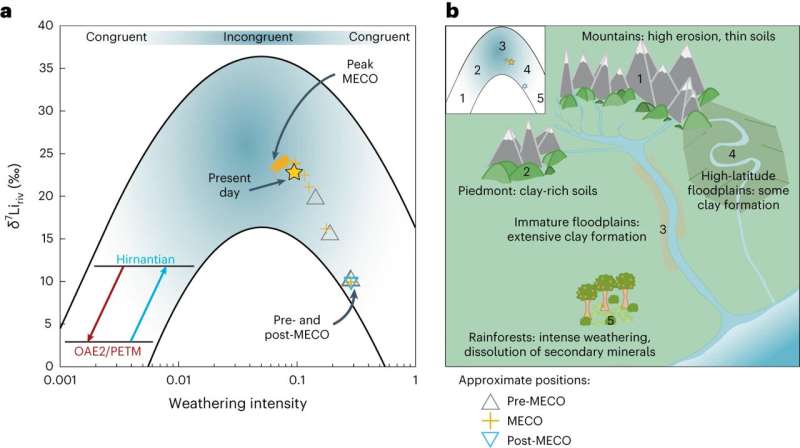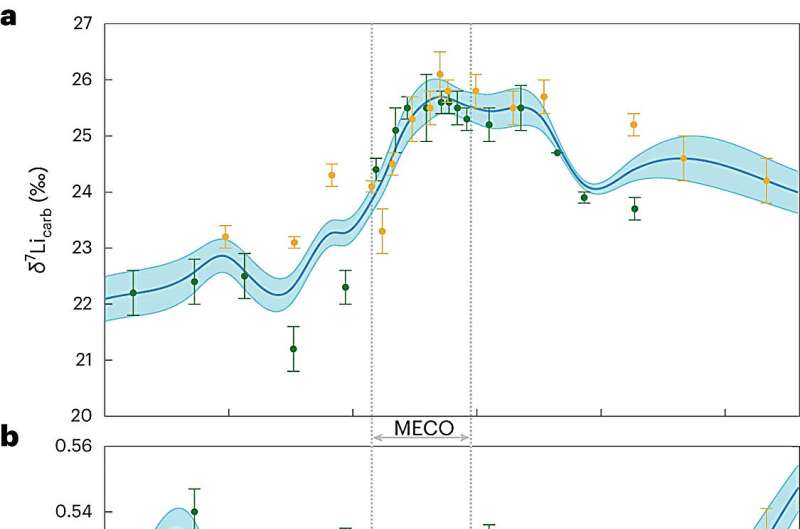
Global warming is not solely a modern-day occurrence but has been a prominent feature of Earth’s geological history for millennia. One such event occurred approximately 40 million years ago, lasting ~400,000 years, known as the Middle Eocene Climatic Optimum (MECO).
This event is considered unusually long when compared to climatic perturbations earlier in the Eocene, such as the Paleocene-Eocene Thermal Maximum approximately 56 million years ago, which lasted ~200,000 years. New research published in Nature Geoscience suggests the MECO may have been impacted by changes to rock weathering, specifically the weathering of silicate minerals, such as quartz, feldspar, mica, pyroxene and clays. Michael Henehan has published a News & Views piece on the research in the same journal issue.
Chemical weathering of silicate rocks helps to counterbalance rising atmospheric carbon dioxide levels, as this gas dissolves in rainwater and the acidic product then weathers rocks, with new minerals formed and often producing calcium carbonate that is then stored on the seafloor. Therefore, drawing carbon dioxide out of the atmosphere helps to reduce the effects of greenhouse forcing and so decreases the planet’s temperature.
Dr. Alexander Krause from University College London, U.K., and colleagues conducted analyses on carbonate rock cores obtained from the seabed from ocean drilling projects in the equatorial and southern Atlantic Ocean and equatorial Pacific Ocean. They measured lithium isotope ratios (the relative abundances of the same element but with different atomic masses, 6Li and 7Li, herein referred to as δ7Li), which is considered an indicator of silicate weathering.
The research team identified a distinct positive peak of ~3‰ in δ7Li coinciding with the climate warming. Significantly, this is the only known positive δ7Li recorded during a warming event. They attribute this to a change in weathering style, from congruent (complete dissolution of the original minerals) to incongruent (partial dissolution with leaching and modification producing new secondary minerals).
While erosion of the source rock has no impact on the lithium isotopes, the formation of secondary minerals such as clays sees the light 6Li preferentially incorporated, leaving the surrounding environment enriched in 7Li, particularly in rivers from land runoff. Therefore, δ7Li in rivers is a direct indicator of rock erosion, and the data suggest that enhanced clay formation during the MECO sequestered carbonate-forming components.
Lithium has a residence time of approximately 1 million years in the ocean before it is removed, hence the researchers state the noticeable shift in δ7Li over the MECO time interval of ~400,000 years is significant. Previous work has suggested that warming events correlate with negative lithium isotopes, but this new research shows the opposite is the case for all three sites. Dr. Krause and co-authors explain this by the influx of hydrothermal fluids to the sites in previous research, while evidence for this is not apparent in any of the sites in this study.

Using a newly development modeling system (CARLIOS biogeochemical box model), the research team used estimates of atmospheric carbon dioxide and temperature along with the lithium isotope data to reproduce characteristics of the MECO in eight scenarios, such as ocean acidity and calcium carbonate saturation at depth.
Only one of these scenarios sufficiently recreated the anticipated MECO conditions, with an increase in atmospheric carbon dioxide from volcanism but a reduction in exposure of calcium carbonate rocks to erosion, plus a decrease in magnesium in seawater which affects the solubility of calcite. Therefore, the result is dissolution of carbonate outpacing sedimentation. The suggestion by Dr. Krause and colleagues is that more clay formation on land would retain calcium and magnesium, which are attracted to clays in soils, thus reducing the calcium reaching the ocean to form carbonates on the seafloor.
The weathering regime for this scenario is plotted on a Dellinger boomerang to determine changes in weathering intensity. Prior to the MECO, erosion was relatively low on high-latitude floodplains being exposed as sea level decline, as well as small pockets in the tropics where near-surface air temperatures likely reached more than 30°C, leading to global net dissolution of secondary minerals.
However, with time an increased hydrological cycle and volcanic activity incising bedrock with lava flows would have changed this to a pattern of primary mineral erosion, with formation of secondary clays. These clays harvested calcium and magnesium, disrupting the transport of the former to the ocean and the carbonate-silicate cycle (terrestrial silicate rock dissolution and marine carbonate formation). Finally, a tipping point would have been reached so that the cycle once again reversed, where clay dissolution outweighed clay formation.
Consequently, a global increase in atmospheric carbon dioxide and surface temperatures alongside the erosion would likely have sustained the MECO for longer and Dr. Krause’s modeling suggests that this weathering regime from ~40 million years ago is not too dissimilar to that experienced today.
More information:
Alexander J. Krause et al, Enhanced clay formation key in sustaining the Middle Eocene Climatic Optimum, Nature Geoscience (2023). DOI: 10.1038/s41561-023-01234-y
Michael J. Henehan, Silicate weathering feedback hindered by clay formation, Nature Geoscience (2023). DOI: 10.1038/s41561-023-01242-y
© 2023 Science X Network
Citation:
Clay formation prolonged global warming event 40 million years ago, according to new biogeochemical model (2023, September 1)
retrieved 1 September 2023
from https://phys.org/news/2023-09-clay-formation-prolonged-global-event.html
This document is subject to copyright. Apart from any fair dealing for the purpose of private study or research, no
part may be reproduced without the written permission. The content is provided for information purposes only.

